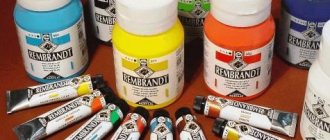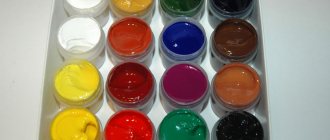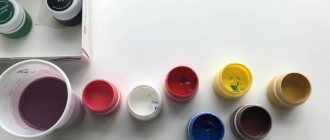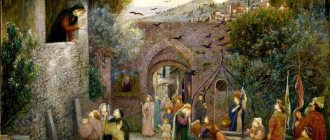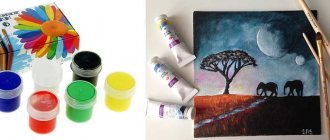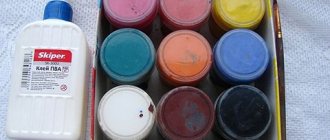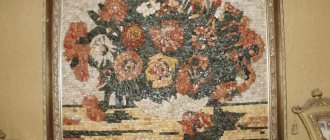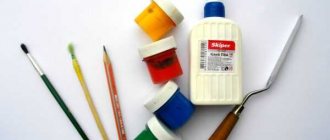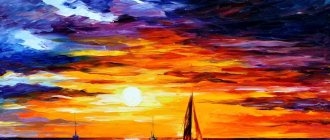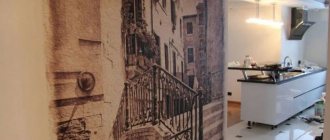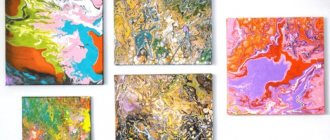Gouache is the art of painting with gouache paints, as well as the general name for these paints. The peculiarity of gouache is its dense matte coating, which allows you to obtain bright and rich drawings. This type of paint has been known since antiquity and was widely used in the Middle Ages, but the term itself appeared only in the 18th century. The peak for this direction in art was the turn of the 19th-20th centuries. Works made in gouache are considered graphics, but recently a number of artists and art critics have insisted that some of the work should be classified as painting.
Advantages and features of drawing
For beginning artists, the ideal material is gouache. The composition contains an adhesive substance and white, due to which the paint turns out opaque. It has a viscous consistency and good solubility in water. The material is sold in sets of multi-colored compact jars. This dye became known and in demand by artists back in the 11th century.
Modern fans of temporary tattoos draw patterns on the body with professional gouache, which is easy to apply and quickly washed off with water. But such paint is not intended for drawings on the body; it is better to use special harmless dyes with natural ingredients.
Gouache is used in mixed canvases and combined with other paints.
The advantages of gouache dyes are as follows:
- The ability to cover an unsuccessful layer of a drawing with a new one.
- Affordable price.
- Fast drying.
- Solubility in water.
It has been noticed that the technique of creating a gouache painting is compared with acrylic art, due to the similar consistency of the materials used. But literally after 10 minutes, acrylic hardens and is not washed off, while gouache is easily washed away with water. This property allows you to correct failed drawings.
The minor disadvantages of this material include fading of the layer after the gouache dries. When applying a dark tone of paint, take this drawback into account. As a result, the tone will appear lighter. Also, after drying, gouache tends to smudge; running your finger over the drawing will leave a trace of color on it.
Peculiarities
Gouache comes from a French word meaning “opaque” and dates back to the Middle Ages. To prepare illustrated manuscripts, artists began to inject glue into water-based pigments. Over time, painters discovered that adding chalk powder or zinc white to opaque paint provided a good masking layer. There are many unconventional examples of gouache being used throughout history to good effect - with works by Durer, Degas, Van Gogh, Picasso all associated with this versatile paint.
Opacity
Gouache is opaque and is produced in essentially the same way as transparent watercolor. Paints consist of pigment, a wetting agent and a binder, but gouache additionally receives an inert white pigment and higher levels of pigment concentration. The result is a smooth, unconventional matte finish that at times appears unusually velvety. Gouache is often used for painting in combination with other water-based materials - acrylic, transparent watercolors, inks and markers, and in dry media - with pastels and colored pencil. Because the pigment is finely ground, the paint is also well suited for use in airbrushing.
Sanguina drawing with red crayons
Similarities with watercolors
Gouache resembles watercolor in appearance and on the palette, but its behavior in the painting process is closer to that of oils and acrylics. Transparent watercolor works gradually accumulate layers of transparent stain from light to dark tones. Gouache works by creating opaque strokes that sit on a surface. The density and opacity allows light tones to be layered on top of darker shades, a quality that contributes to a distinctive approach to painting.
The drying time of oil paint precludes its use in applied painting - drying occurs almost instantly.
Solubility in water
While acrylic paints become completely insoluble and impenetrable when dry, gouache can be easily dissolved with water. An unconventional feature is the ability to blend already dried colors with a soft, damp brush - this allows you to achieve subtle shading effects or dramatic changes throughout the painting process. Underpainting in the work can be done by mixing elastic, acrylic matte dye with gouache.
Types and choice of paint
Gouache is painted on a thick surface, which can be white paper, cardboard, a wooden board or canvas.
There are several types of gouache used in creativity:
- Artistic paint is used in painting and has the properties of absorption into the surface of application. Subsequent layers applied on top of the initial stroke give the painting brightness and richness.
- The poster variety has brighter coloring properties and rich pigmentation. Used for decorating theatrical scenery.
- The PVA glue contained in children's paint speeds up the drying time. It is used to apply strokes to plywood or ceramic surfaces.
- Acrylic gouache is suitable for all types of surfaces, retains its shade and does not wash off.
- Fluorescent is an unusual gouache that can glow under the influence of ultraviolet light. This type of paint gives the drawing a special sophistication.
Gouache is a type of water-based paint, which distinguishes it from others and is an advantage.
How to choose the right gouache?
- First, you need to decide on the purpose of its use. The paint is sold in small tubes or jars, not intended for bulk paintings. To prevent the painting from being exposed to a humid environment, a varnish is used to protect the painting.
- Secondly, calculate the amount of coloring material, which depends on the scale of the planned masterpiece. For beginning artists, it is enough to buy a minimum set with containers of 20-40 ml. This quantity is enough for ten paintings in printed sheet format.
- It is advisable to start your art with a child's type of paint, gradually moving to more professional types. Having learned to understand the transitions of colors, it is recommended to use “Master Class” gouache in any packaging.
- You must purchase the material taking into account the date of its manufacture. Only if you have fresh raw materials will the work bring pleasure and delight you with the result.
- The smell of the paint should be weak, its consistency should be uniform, the color should be bright, but not poisonous. Pay attention to the manufacturer.
Gouache: its features, advantages and disadvantages
Gouache, like watercolor, is a water-based adhesive paint to which white has been added. The term Gouache itself, which comes from the French language, comes from the word “splash” (meaning the splash of water). If you look at works done in watercolor and works created with the help of its sister, gouache, you can immediately see the difference. They look like the exact opposite of each other:
- watercolor drawings are distinguished by transparency, lightness, blurriness;
- gouache is dense, opaque, rich, matte. Graphic drawings are distinguished by clarity. Closer to painting are textures achieved by modeling volume with color.
When working with gouache, you should consider its pros and cons. Benefits include:
- excellent covering characteristics. This allows light shades to be applied over dark ones and vice versa, which gives the artist freedom to vary the tonal saturation;
- quick drying;
- good paint control;
- uniform texture;
- color saturation;
- velvety matte finish, giving the paintings originality and nobility.
But artists should also take into account certain nuances of paint that make work difficult:
- Gouache works are difficult to correct due to their thickness and quick drying. As a rule, corrections are made by overlapping one paint layer with another (after complete drying);
- if the paint layer is too thick and dense, its fragility will increase and it will quickly become covered with cracks. Therefore, in order to apply thick impasto strokes, it is necessary to mix strengthening additives (for example, wood glue);
- Due to the addition of white, the colors will become lighter over time, which should be taken into account initially.
Due to its good hiding power and saturation, gouache has become widespread in poster art, illustration and in the design of theatrical scenery. But this played a cruel joke on her: many believe that this is where the possibilities of artists working with gouache are exhausted. Actually this is not true.
Gouache artists also create easel works using various techniques. These works can be done both in a graphic and painterly manner.
Depending on the tasks, the master chooses the appropriate type of paint - poster or artistic. In addition, there are now options with various additives: fluorescent, pearlescent, and metallic. The scope of their application has also expanded: for example, such gouache is widely used in airbrushing.
As for the base, it can be not only paper, but also cardboard, plywood, parchment, as well as canvas or silk with a special impregnation that imparts hardness.
What you need for drawing
Creating gouache pictures for beginning artists is not easy.
In addition to the purchased paint kits, you will need the following components:
- brushes;
- surface base;
- water to dissolve paint;
- plastic palette.
You can buy brushes in art shops; their assortment is huge. The ideal brush for gouache is natural compositions that have one drawback - the ability to shed. Brushes made of bristles and synthetics are popular.
During the creative process, you cannot put pressure on the brush; it fluffs up and loses its original shape. There is no need to constantly dip the brush into a glass of water.
Before changing the shade, the instrument is thoroughly rinsed, but it should not be left in water. Real artists choose several brushes of different sizes and shapes.
You can paint with gouache on any surface: paper, lightened cardboard, wood or canvas. The substrate must be dense and treated (wood) due to the fact that the paint is heavy. Many craftsmen prefer a schematic sketch. It does not have to be done accurately and accurately; the gouache layer has a dense structure, the sketch on the canvas will be painted over, and its lines will be invisible.
Watercolor artist K. Kuzema: “The watercolor technique is simple. You just need to be able to correlate the amounts of water and paint on the brush and paper at the same time.”
Water acts as a paint thinner; its volume varies in thickness. In the process of selecting the concentration of the paint mixture, the overly diluted paint becomes transparent when dried, and the lines of the pencil sketch protrude through this layer. Gouache, which is mixed on the palette, has the consistency of thick sour cream.
Application methods
To paint with gouache, you need to master mixing water and paint on a brush. Gouache should not be so diluted that it flows freely. If the paint is not thinned enough, it may pull a significant layer of paint over the entire surface or be prone to cracking.
Impasto painting technique
The recommended consistency is similar to a cream - the paint will flow smoothly from the brush and cover the surface evenly.
Multiple layers
When applying layers one on top of another, it is important that the first one is completely dry. Otherwise, the wet layer will change color and shape. If the second layer is too wet, the same effect will occur. Care when removing the lower colors results in beautiful subtle effects. The paint is removed with a damp brush with new pigment - discrete layers are mixed with subsequent balls of paint if necessary.
There are several ways to approach changing shapes and mixing colors.
Wet on wet
The wet-on-wet technique is used in watercolors and oil paintings. In gouache the effect can be quite subtle, but is limited to working in small areas.
Wet on dry
Using the “wet on dry” method is recommended to be done with a dry, stiff brush to completely hide the earlier layer - this is useful for making corrections or changes in the work.
Dry brush
Dry brushing is an excellent rendering technique for gouache. After filling the brush with paint, remove excess moisture with a dry paper towel. The use of a dry brush is used in painting for detail.
Painting with wet watercolors
Grain
Hatching and graining are obtained due to the softening effect - directional impasto shading with a brush is added to the texture.
Drawing technologies
Many famous artists use different techniques for painting with gouache.
Beginners learn the most common methods, arriving at the most suitable one.
- “Wet on dry” - paint is applied with a brush to a layer that is finally dried. Corrections are made this way.
- “Wet on wet” - paint is applied in layers to a still wet surface. The strokes lie tightly and the drawing takes a long time to dry. This technique is used to create watercolors.
- Spraying - wetting the brush in the coloring material, spray it onto the main panel. An easy and fun way to create small parts.
- A textured picture is created using a sponge that imitates the texture of the earth and foliage.
- Masking is performed using a special liquid. If there are areas in the drawing that should remain unpainted, they are covered with this liquid, and at the end of the work they are wiped off along with the created film.
- Using a dry paint brush moistened only with paint, draw the details of the design.
- Highlighting, scratching are additional techniques that correspond to the names. Performed with sharp sticks or a knife.
- Lightening - the paint is washed off with a wet piece of cloth until the desired shade is obtained.
All of these techniques are used when working with gouache. You need to study on a sheet of paper, and later use canvases and canvases. In experiments, you can change the thickness of the paint, use a variety of brushes and auxiliary tools.
Only with visual actions can the best techniques be selected.
Basic gouache painting techniques
Basic gouache painting techniques
- Valeur is a subtle tonal gradation of one color.
- Wet-on-wet ,
you thin the paint a little more than usual, apply it to the paper, and quickly add thinned paint of a different color on top. After this, the colors will begin to blur, forming bizarre shapes with soft, blurry edges. If this does not happen, it means that you did not dilute the paint thinly enough, or you were too late in applying the second layer, and the bottom layer of paint had already dried by this time. To avoid this, I advise you to pre-moisten the paper with a brush dipped in clean water.
- Gouache shading with color transition is an artistic technique that is often used to create a beautiful background with a smooth transition in tone. Allowing you to achieve a smooth transition of color from dark to light or even reduce the color to a white background. It is carried out as follows: the selected shades are applied in horizontal stripes, after which we gradually begin to smear the paints (the paints should not have time to dry). Movement of the hand from right to left, then from left to right. You can also use a sponge to create a smooth transition.
4. Impasto is a technique that involves applying thick paint in thick layers. If you want to use impasto, take a tube that you have used more than once: this paint will be thicker than new paint that has just been opened. Gouache can also be thickened with an acrylic additive or a special Aquapasto additive from Winsor&Newton, created for using the impasto technique when working with water-based paints.
5.
Carnation - application of paints in several layers.
Used to depict human faces and body parts. The technique made it possible to achieve maximum realism in the image. 6. Glazing is
a method that involves applying transparent layers of other tones over the main color.
By covering the base color with translucent layers, a new deep shade is obtained. For gouache this method is available in the same way as for watercolor. The gouache needs to be diluted quite heavily with water so that it becomes transparent. Using the glaze technique, you can create a unique fog effect; gouache is suitable for this like no other material. 7.
A stroke is a mark left by a brush. In oil painting, strokes can be more expressive due to the greater thickness of the material and the thickness of the paint layer. Using the brushstroke technique, you can enhance the dynamics and give the work additional expressiveness. They write with strokes on paper of any moisture content. But best results can be achieved on slightly damp and dry paper.
8. Monotype
(from the Greek “monos” - one, united and “tupos” - imprint) is one of the simplest graphic techniques, the origins of which go back to the 17th century. The essence of monotype is to apply paint by hand onto a flat and smooth surface, followed by imprinting on another surface (on a machine) or on paper folded in half. The resulting print is always unique, and it is impossible to create two identical works. Next, the resulting color or monochrome blots are either left in their original form, or a suitable image is thought out and the missing details are drawn.
9. Multi-layer painting -
the most important technical variety of oil painting,
requiring the division of the work into a number of successive
stages (underpainting, registration, glazing), separated by breaks for complete drying of the paint. When performing a large thematic composition, as well as during long-term work in general, multi-layer painting is the only complete oil painting technique. Until the middle of the 19th century. all the major advanced artists of the past used this technique as their main one. Later, the Impressionists and their followers abandoned it.
10 . The impasto technique is also available in gouache. This technique involves applying thick, opaque paint to the work surface. This technique is inherent mainly in oil painting. Texture, light and shadow in paintings painted using the impasto technique depend not only on the color, but also on the shape and direction of the strokes applied. Gouache can also be used in this style, especially if it is PVA-based or acrylic. When working in the impasto technique and using ordinary artistic gouache, you need to remember that too thick a layer of this paint tends to crack and crumble after drying. Therefore, you need to very carefully add layers of thick gouache to the canvas in order to obtain the “golden mean” necessary for this technique and material.
11. Uniform filling with a brush
- used for painting surfaces or parts thereof. Done with a brush. The gouache should not be too thick (the paint will form clumps) or too thin (spots will appear). Fill the outline starting from the edges.
12. Splashing
- a very simple and pleasant way to create texture. Using this technique you can draw pebbles on the road, river pebbles, leaves and the like. It is best to spray gouache using a small paint brush (preferably a new one and designed to work only with gouache, but not with drying oil or water-based paints). Load your brush well with paint, pull the bristles back (away from the painting), and then quickly release them. The bristles will rush forward and a whole cloud of small droplets of paint will fly off them. In order not to splatter the entire painting, make a paper mask cut from a newspaper or an unnecessary sheet of paper and cover the part of the painting that should not be splattered.
13. Mixed media
- In addition, gouache is perfectly used in mixed painting techniques. For example, the background is made with gouache, and the drawing on the background is made with acrylic. Flowers made with gouache and acrylic are very impressive. Gouache can also be used in combination with watercolor, pastel, and tempera.
14. Dry Brush
- in painting and graphics, an auxiliary technical technique consisting of working with hard brushes that are weakly saturated with paint. As an independent technique, dry brushing is used mainly in decorative arts. The technique externally imitates colored pencils. Easy to perform. Makes it easy to mix colors directly on paper.
15. Stamping—
making impressions using a sponge, cotton wool or even a crumpled sheet of paper. . This can be especially successful at simulating rough ground, thick grass or foliage. In addition to a sponge, texture can also be created with a strip of corrugated paper or cardboard folded several times, and very unusual and unexpected effects arise.
Memories of Summer
Yellow colorful sunflowers in a vase are the embodiment of warm summer days.
This picture lifts your spirits on any day.
To create flowers on paper with gouache for beginners, you need to follow the tips step by step:
- Make a pencil sketch, schematically indicate the direction of the stem, leaves, petals.
- Prepare gouache “Master Class 12 Colors” by selecting the desired shades.
- Paint the petals with a thin brush and allow time to dry.
- Draw a vase in the same way, noting its lines, dimensions and base.
- Schematically divide the vase into three even parts.
- Create the bases of the oval, combining them into one large one.
- Paint the vase with colored paints.
It is important to know: it is not necessary to buy a large number of gouache shades. Buy: white, black, blue, yellow, red, brown. Other colors are created by mixing primary colors.
The result is a worthy picture that decorates the room. You can draw any flower arrangements, bouquets. In art lessons, children often draw flowers. This is the simplest option on which you can practice the subtleties of gouache painting techniques.
Step-by-step methods will help even children understand the basics of drawing. The ability to carry out sequential actions, choose paints and brushes will help reflect the natural beauty on the canvas.
The depiction of a landscape in gouache begins with a pencil sketch of the drawing diagram. It's easier to start from the top of the picture, with the blue sky, then move on to the white clouds. Clouds are painted with whitewash, waving the brush across the sky.
Mountains are depicted with brown colors, plants with green colors. The main condition is to choose colors that look realistic. Sometimes the paints are mixed on a sheet, changing the water frequently. After finishing the work, let the painting dry and varnish.
Once you understand the process and techniques of painting with gouache, you can achieve success in the fine arts. Moving step by step, beginning masters master skills gradually.
In addition, drawing is a useful activity for developing imagination and thinking. While a person is drawing, he feels calm, peaceful, immerses himself in another world, forgets about troubles and problems.
Looking at the paintings of famous artists, you involuntarily admire their creativity and ability to depict the world around them in bright colors. Each of us can also try to master the art of drawing and make this hobby our favorite pastime. Here are beautiful gouache drawings for beginners; they will allow you to test your talent in painting and master the technique of painting with paints.
What do aspiring artists need to know?
To master the gouache painting technique for beginners, you need to have:
- Set of gouache paints of twelve colors.
- A pair of flat pig bristle brushes.
- Palette and dishes with water.
The aroma of gouache paints is familiar to everyone from childhood. It is not difficult to understand how to draw with gouache; the technique of such drawing is quite simple. You need to draw, starting with a pencil sketch.
A palette knife is used to apply paint and mix it. With its help you can apply paint in even strokes.
From an early age we draw a simple, unpretentious landscape in gouache in an album. But, you can paint patterns, flowers, mountains, and even city buildings with such paints. For beginners, working with gouache is simply an ideal option.
By drawing a sketch with a pencil, you can avoid mistakes and do the work accurately. If you smear and mix paints directly on the canvas, you will just end up with dirt on the painting. Therefore, you can add a little water to gouache and it will turn into watercolor.
Techniques for using different paints
How to paint with acrylic
Acrylic paint perfectly combines the best properties of watercolor and oil, and after drying the paintings are not afraid of moisture and sunlight. Even a child can make simple drawings with such paints.
The universal properties of acrylic lie in the ability to apply each subsequent layer to the previous image. Unlike watercolor, you don't have to wait for a layer to dry before applying a new one. Read the easy instructions and get started!
To begin with, you can learn to use six colors. Later, the palette will gradually expand to 18 shades. Also prepare:
- The surface for the painting is wood, glass, plastic, paper, cardboard, canvas.
- A set of brushes made of synthetic and natural materials.
- Palette.
- Water.
To obtain high-quality paint, it must be diluted with a solvent or water. Undiluted paint is used on synthetic surfaces and dries faster.
There are several techniques for painting with acrylic:
- Wet - on a canvas that has been moistened with warm water.
- Dry - using several brushes.
- The method of glazing in layers is to apply a thick layer and then paint a picture.
- “Impasto” – similar to oil paints, with wide, clearly visible strokes.
For a drawing, a novice artist needs to choose a base surface and paint in a jar or tube. Choose a drawing technique that interests you. Prepare a palette of colors.
Synthetic brushes are more suitable for working with undiluted paints. If you choose a watercolor technique, it is better to use natural bristles.
At the end, you can additionally apply strokes with a felt-tip pen, ink, marker, gel pen, or pencil. Even a child can master the simplest drawing technique from scratch.
Once you master the basics of the technique, you will be able to draw on fabric and glass, create aerial landscapes or portraits. Even painting your favorite T-shirt will be easy if you learn how to work with acrylic.
On video: step-by-step acrylic painting lessons.
How to draw with gouache
Children master drawings with gouache paints for beginners at an early age. This paint is loved by kids for its ease of application and because the image does not blur, unlike watercolors. Gouache allows you to get more vibrant drawings.
For older people, instructions from the Internet will help them create a unique landscape. The basis of the pattern can be the following surfaces:
- Paper.
- Plywood.
- Glass.
- Fabric.
There are the following types of gouache:
- Artistic.
- Poster.
- For children.
- Acrylic gouache.
Immediately draw a sketch with a simple pencil. When learning to draw, start with dark shades, gradually moving to light tones. Mix paints on the color wheel. Step-by-step drawing with children will allow you to get beautiful images on paper.
If you mix adjacent colors in a sector, you will get a dirty shade. Shadow can be rendered with green, blue or purple, but not black.
Whatever technique you choose, the main thing is that inspiration comes to you. We wish that all your works are successful, that you like them, and that they give you ideas for further creativity. With the help of such an activity you can throw out your emotions and impressions. Draw with confidence and pleasure!
Master classes on painting with watercolors and gouache (2 videos)
Beautiful drawings and what was needed for them (38 photos)
Gouache painting techniques
Among the techniques known to artists for painting paintings with gouache, the following are common:
- Apply a wet layer of paint over the not yet dry layer. In this case, the paint applies tightly and takes a long time to dry. This method is more suitable for painting with watercolors.
- Using a dry brush, gouache paints are applied to the dried layer.
- Using a sponge, a textured picture is created. This technique is ideal when we are painting an autumn landscape; we can easily depict the bright colors of golden autumn.
- For a beginner, the technique of splashing paint on the canvas will cheer up and help overcome anxiety. It is enough to wet the brush in paint and spray the gouache on the paper or canvas. The result is a bright and beautiful painting. Be sure to learn this method of applying paint, which helps train your hand.
Of course, we cannot paint a picture without the right brush. It is advisable to choose brushes made of nylon, goat or pig hair.
On video: how to beautifully paint the sky with gouache.
Japanese and English watercolor painting techniques
- The Japanese technique of watercolor painting, like the entire Eastern culture of drawing, differs from the European one that is familiar to us.
Firstly, in this technique they draw not on cotton paper, but on rice paper. It is thinner and more delicate.
Secondly, and this follows from the point above, watercolor paints differ from ours in their composition, since the watercolor we are used to is not suitable for rice paper.
As for color, in Japanese watercolor technique the primary colors are natural colors, green, blue, red, etc.
As a rule, such paints are not mixed with each other, which implies the absence of multi-layer techniques.
The execution of a drawing with watercolors using the Japanese technique is quite simple, but due to the unusual materials it looks very beautiful and interesting.
- The English technique of painting with watercolors is the same technique of painting on wet. To work with this technique, you need to moisten a sheet of paper with water, securing it to the tablet so that there are no waves.
Since this is a wet-on-wet technique, there will be no clarity in the work. Only after the drawing has dried can you add details and retouch what is missing in the drawing.
This technique is more complex than others, so it is better to start learning it by mastering a few simple techniques that I wrote about above.
Types of gouache
Gouache is suitable for painting on cardboard, paper, canvas and other surfaces. But not every gouache has such universal properties. Let's look at the main types of such paints:
- Artistic gouache. Suitable for use on surfaces intended for painting only. It is absorbed into the material and allows you to apply a second layer, making the colors in the painting more saturated and bright.
- Poster gouache. It has a more saturated pigment and bright coloring abilities. It is used to decorate theatrical scenery. Children's gouache contains PVA glue, so it dries quickly. This gouache is convenient to work on plywood, ceramics or canvas. But acrylic paint fits perfectly on any surface, and after drying it does not wash off and does not lose its original color.
- Fluorescent gouache. Amazing in its properties and quality. It glows when exposed to ultraviolet rays. The color is too bright, which gives the picture a special beauty.
Technicians
Gouache painting is distinguished by various drawing techniques.
Pastose technique
Characteristic of the technique is the application of undiluted thick strokes to the surface. Depending on the direction of the stroke, the texture will change. PVA glue added to the paint will help you achieve a better result. It will serve as a fastening element and will not allow the gouache to crack.
1 / 2
Light strokes should be applied first; after they have dried, the artist begins to paint with gouache with dark pigments. When the drawing is dry, take a special tool and scratch the top layer of paint with it to reveal the bottom one. The technique is reminiscent of engraving and allows you to create original textures.
Glaze
1 / 2
The “glaze” painting technique involves applying translucent layers of paint in several stages. The maximum permissible number of layers is 5. Moreover, each previous layer must dry before applying the next one. If you do not follow this rule, you will end up with a “dirty” color and the drawing will be ruined. Proper execution of the technique allows you to create complex tones and stunning pictures.
On wet
1 / 3
This technique is a habit for watercolor lovers. Its use involves diluting the paints with more water than usual. Several colors are applied to the paper, they begin to spread, acquiring interesting shapes. If this does not happen, it means the paint is not diluted with water enough. To avoid this, you can moisten the paper a little with water.
splashing
A simple method for creating texture. It is better to spray paint using a small paint brush. It is dipped into the paint, with the bristles being pulled away from the painting and then suddenly released. A cloud of small drops of paint is sprayed. The part of the picture that should not be splashed should be covered with another sheet of paper.
1 / 3
You can also highlight “wet on dry”, “dry brush”, graininess, etc.
Additional recommendations
A step-by-step method helps even children understand the basics of painting with gouache. Such lessons will allow you to master this wonderful creativity and learn how to paint in a certain sequence, choose the right paints to reflect the real beauty of nature, representatives of the flora and fauna on canvas.
To create pictures of nature, like drawings on any other topic, you need to start with a pencil sketch. It's easiest to draw by starting at the top of the canvas or piece of paper. As a rule, at the top is the sky, which is colored blue along the pencil contours.
Clouds are painted with whitewash, brushing white highlights across the blue sky.
Mountains are depicted in brown colors, and vegetation in green tones. The trees below are depicted in lighter or darker green gouache. The main thing is that the colors in the painting look like in reality. Paints can be mixed directly on the sheet, changing the water periodically. To create fine lines, you need to choose the right brush.
When using gouache, you must adhere to the following tips:
- You can buy gouache in tubes or jars; everyone chooses the most convenient packaging for themselves.
- The colors you need to choose are those that will be needed to work on the painting.
- Tests should be done on the palette, only after selecting the desired color, transfer it to the canvas.
- If the paint cracks, add a little gum arabic to it and stir thoroughly.
- To apply the next layer, you need to wait until the previous one has dried.
- It is advisable to coat the painting with varnish after drying.
Having mastered the technique of drawing, you can achieve success in artistic creativity. Moving step by step, from simple to complex, beginning artists gradually master the technique of painting with gouache. Below are video tutorials, the purpose of which is to help you depict the chosen plot on the canvas as accurately as possible. This step-by-step approach allows you to quickly learn how to work with paints such as gouache.
Gouache painting lessons for beginners (2 videos)
Many people like to visit art galleries and exhibitions, and get acquainted with works of art on the Internet. Most of them don’t even dream of learning how to draw the same way. Others allow themselves not only to dream about it, but also take the first steps towards mastering initial skills. For contemporary artists, there are a huge number of different materials. Today we will talk about gouache.
If you want to learn how to draw and have some free time, start studying at a private art school. Gouache painting lessons can also be found on the global network; many professionals and amateurs share their experiences on the Internet. This article is intended for beginner artists; it will give a general idea of gouache, drawing techniques and the features of working with paint.
Secrets of working with gouache
There are a number of tips that artists always follow when working with paint. Here are the main ones:
- draw from dark to light - first draw dark tones, then add highlights, light spots;
- combine shades, not forgetting about the circle of light (colors that are nearby give tones without dirt or gray impurities);
- to draw the contour, take the tone from the opposite sector;
- draw shadows blue, green, purple, but not black;
- correct blots after the gouache has completely dried;
- when drying, the gouache will lighten, so you need to take brighter colors;
- instead of a palette, you can use cardboard or a board for mixing paints;
- clouds in the sky are painted with ordinary white paint, grass with green paint, and trees with a green tone lighter than the grass.
You need to advance in skill step by step, from simple to complex, then the drawings will come out more and more successfully.
What is gouache?
The composition of this paint includes ground pigments, a water-based adhesive base and white.
The main difference between gouache and watercolor is that watercolor is usually applied in several layers, so you can play with the final result. With gouache, applying several layers of paint does not make sense, because the human eye in the picture will only see a layer of gouache applied on top of the rest.
What is gouache
Experts recommend starting to learn painting by using simple materials, which include gouache. It is easy to apply to any surface, including ceramics and fabric. To work, you only need a brush and water, no other aids.
1 / 3
Gouache is a water-soluble paint. It consists of coloring, finely ground pigments, white and adhesive binders. It belongs to opaque paints. It has a stronger color than watercolor.
1 / 3
The basis for creating gouache was watercolor, into which titanium white paint was introduced, which led to an increase in density. Painting with this paint has a specific feature - its pigment dries quickly, acquiring a lighter shade.
1 / 3
The properties of gouache allow you to eliminate any shortcomings. To do this, you need to wait for the previous layer to dry and apply the next one, correcting the errors.
1 / 5
Modern artists' opinions about gouache vary: some believe that it is children's paint. But in fact, it is an independent technique on a par with watercolor. With its help they create beautiful still lifes, portraits, landscapes.
Gouache drawing lessons. How to choose gouache?
There are the following types of gouache:
- Artistic gouache, for working with which uncoated cardboard, watercolor and tinted paper are suitable as a surface. The paint is ground pigments with the addition of water, white and gum arabic.
- Poster gouache is different in that it is produced using kaolin instead of white. This makes the paint denser and the colors applied brighter.
- A special gouache for children's creativity contains PVA glue, which replaces the more expensive gum arabic. This composition allows the paint to dry faster, crumble and wear less. With the help of children's gouache you can paint on paper and plywood, on ceramic products and canvas without primer.
- Acrylic gouache is used for painting all possible surfaces, and after drying it is not washed off with water.
How to draw with gouache: drawing basics step by step
Translated from Greek, gouache means “water paint”. And to understand the difference between this paint and the same watercolor, let’s look at its features. Gouache is a dense, opaque paint; with its help you can achieve a uniform paint layer without bald spots. In gouache, water serves as a thinner or brush rinser.
Gouache is a bright, rich paint that becomes slightly whitish when dry, but this only makes it more charming. Gouache is very much loved by artists who are engaged in decorative creativity.
Before the invention of new printing technologies and the spread of this type of reproduction, gouache was often used to create posters and illustrations, because it allows you to cover large areas with paint. And now gouache is often used by artists, despite a number of its disadvantages:
- Gouache has a chalky base, as a result of which when drying the color becomes very lighter and whiter. Therefore, it is very difficult to create paintings with such material - sometimes it can be difficult to choose the right shade of paint.
Choosing a brush for painting with gouache
Brushes that are too soft are not suitable for working with gouache. For shading, backgrounds and fills when working with a damp brush, kolinsky, goat and synthetics are perfect.
To depict a complex structure, you can also use a foam sponge, special rollers and ordinary paper napkins instead of a brush. With their help, you can achieve maximum realism by drawing the roughness of ceramic products or drawing a still life.
How to create a background for gouache?
Two methods are used to draw the background:
- The artist makes a pencil sketch and then fills in the outlines, starting with the dark elements. The contour is filled without pressing from the edge to the center, then from the center to the other edge. The consistency of thin sour cream can serve as a guide to determining the desired thickness of paint. This method is suitable for working with a small pattern.
- If the surface is large, then it is better to use the filling method, when the background is painted first, and only then the details are drawn. Most often, the background consists of two or three colors. For a landscape, for example, the color of the sky is used in the upper part of the picture, the color of the earth in the lower part, and the lightest stripe is applied in the middle.
Gouache technique
Topic 2.4. Painting media.
Methods and techniques for working with paints.
Performing sketch exercises to master various techniques and painting materials (gouache, watercolor)
Techniques for working with gouache and watercolor, using various techniques for working with paints from this manual.
Exercise. Format A 4 – on one sheet of paper, compose 2 abstract compositions on the theme of conventional abstraction. The size of the composition is 10x10 cm, the distance between the squares is 1 cm. The name is indicated at the top of the sheet. An arbitrary format frame is set. Contrast, Nuance. Warm and cold colors. Title of the composition. In this task, you can use mixed media in painting, experiment and create your own techniques for working with paints.
Abstractionism is a style or direction in painting. Abstract art or the abstract genre implies a refusal to depict real things and forms. Abstractionism is aimed at evoking certain emotions and associations in a person. For these purposes, paintings in an abstract style try to express the harmony of color, shapes, lines, spots, and so on. All shapes and color combinations that are located within the perimeter of the image have an idea, their own expression and meaning. No matter how it may seem to the viewer, looking at a picture where there is nothing except lines and blots, everything in abstraction is subject to certain rules of expression.
Improving these techniques will greatly simplify working with large format paintings.
Mixing all techniques will turn drawing into fun and exciting creativity. The result will be an original designer art panel.
Exercise. Create a decorative stylized still life using various techniques for working with paints from this manual. A3 format. Linear sketches of still lifes made in graphics can serve as sketches. In this task, you can use mixed media in painting, experiment and apply your own techniques for working with paints.
Exercise. Complete a composition on A3 format in the style of abstractionism on the theme “Space”, using various techniques for working with paints from this manual. Sketches of a formal abstract composition can serve as sketches. In this task, you can use mixed media in painting, experiment and apply your own techniques for working with paints.
Gouache technique
Gouache is an opaque dense paint consisting of finely ground pigment with a water-based adhesive binder. Gouache paints are produced in two types - poster and artistic. Poster gouache is more viscous, has greater covering power and color saturation. But we are interested in artistic gouache; it can be used to create very beautiful works.
Gouache can be safely used for architectural drawings, paintings or for plein air work. Gouache graphics vaguely resemble graphics with oil paints.
The technique of working with gouache is quite complex and includes various artistic techniques. It should be said that working with gouache paint requires certain skills and a fair amount of patience.
So what are the techniques for using gouache?
1. Uniform filling with a brush.
Used for painting surfaces or parts thereof. Done with a brush. The gouache should not be too thick (the paint will form clumps) or too thin (spots will appear). Fill the outline starting from the edges. If you need to make perfectly straight edges to create a contour, you can use masking tape, medical tape, self-adhesive paper, or simply place sheets of paper or thin cardboard. When painting areas of more complex shapes with rubber glue grade A (sold in hardware stores), tracing paper “under mascara” is glued on, which is carefully cut along the required contour. After applying the paint, the tracing paper is removed from the areas to be painted, and the glue is wiped off with an eraser or your finger.
2. Gouache fill with color transition.
An artistic technique that is often used to create a beautiful background with a smooth transition in tone. It is carried out as follows: the selected shades are applied in horizontal stripes, after which we gradually begin to smear the paints (the paints should not have time to dry). Movement of the hand from right to left, then from left to right. You can also use a sponge to create a smooth transition.
In this work, the background is made using the technique of filling with a tone transition.
3. “Dry brush.”
The technique externally imitates colored pencils. Easy to do. Makes it easy to mix colors directly on paper. The sequence of execution is as follows: take a little paint onto a dry flat bristle brush, wipe the excess paint on the paper until each hair of the brush produces a separate line. Brush strokes are made on the paper in the chosen direction. Do not wet the brush while working!
4. Stamping
- applying impressions using a sponge, cotton wool or even a crumpled sheet of paper. A sufficient amount of paint is applied to a flat palette, the stamp is dipped in paint, and then the stamp is applied to the surface with the stamp. Please note that if there is too much ink on the stamp, you will not get a stamp impression, but a smear. But if you work with a stamp like a brush, you can get very interesting options.
Gouache painting techniques
You can use various painting techniques when painting with gouache. The following techniques are suitable for beginners:
- Glaze. With this method, translucent layers of other shades are applied on top of the main color, resulting in a new, deeper color. Translucency is achieved by diluting the paint with water. This technique is great for depicting fog.
- Pastose technique. This method involves applying thick, undiluted gouache to the surface. In this style, it is most convenient to work with children's and acrylic gouache, since they do not crack or crumble.
- Sgraffito is a gouache technique in which light paint is first applied to the surface, and after drying, a thick layer of dark-colored gouache is applied. When it dries, using a drawing pen, a stylus and a thick needle, a design is created by removing the top dry, but still fresh, layer of dark paint.
- Mixed technique, in which the background, for example, is painted in gouache, and the elements of the composition are applied with acrylic paint.
Properties and features of gouache paint
The main advantage of gouache is its ability to evenly cover large surfaces with one shade, which makes this paint a favorite of many famous artists. Another advantage is the ability to correct an incorrect stroke by adding another layer of paint on top.
1 / 5
However, there are a number of disadvantages:
- When the paint dries, the main pigment becomes significantly lighter . To learn how to choose the right tone when drawing, you will have to spend a lot of time and effort.
- If you apply too thick a layer of paint, it will cause cracking and crumbling . An unsuccessful smear, corrected more than three times, will not take root.
Step-by-step painting with gouache
Let's look at a simple example of how to draw pictures with gouache. We will gradually perform one step after another in order to draw a tree:
- Since we are planning to draw a tree on a winter day, we will first paint a background of snow and sky. In the place where you plan to draw a tree, we recommend highlighting the sky with a brighter color, since the white branches dusted with snow should be clearly visible against its background.
- After the background has dried, use a simple pencil or immediately paint a dark shade to draw a tree with branches.
- We continue to work on the tree: draw brown branches near the trunk and white thin branches at the ends.
- After this, it is necessary to detail the tree itself and the white branches.
- Since the background of sky and snow itself looks a bit boring, we introduce additional colors. You can, for example, add a little light pink, lilac or peach shade to the background. This will enliven our drawing and make it more interesting.
As you can see, even a not very experienced artist can paint such a simple picture. You just need to have paint, a piece of paper, a brush, water on hand and, of course, a strong desire to learn how to draw.
